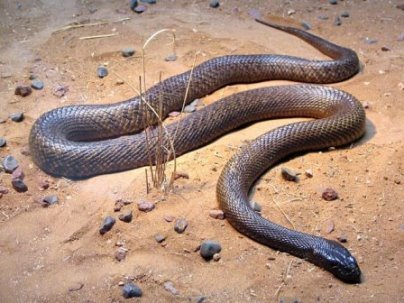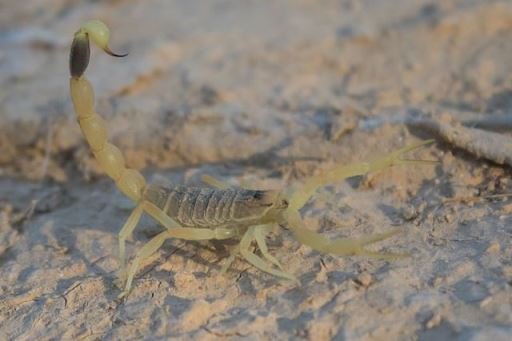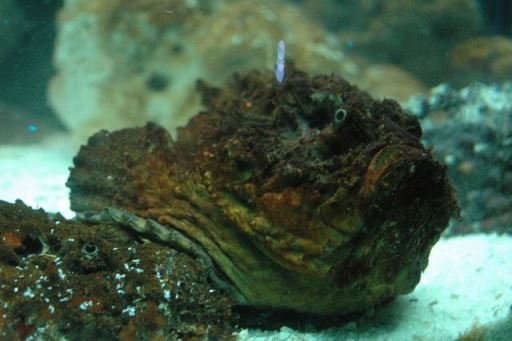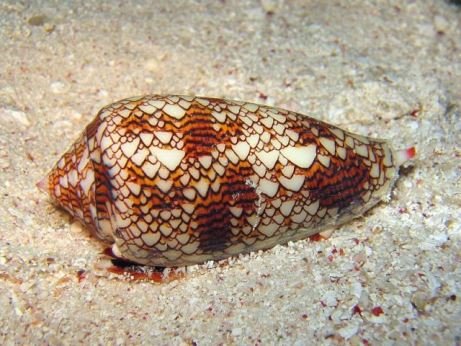The 'Baddest' and Most Poisonous Animals Around Us - Pt 2
This is going to be the second part of the article on the 'baddest' species of lifeforms existing around us, with focus on their poisonous nature.
From the previous post we discovered scary and fascinating details of the Phoneutria (Brazilian Wandering Spider), the Golden Dart Frog, the Blue Ring Octopus, and the Paraponera Cavata (The Bullet Ant).
Today I would be featuring some other dangerous species of animals and insects, alike found on our planet, and sometimes around our geographical locations.
Let’s start with the reptile today. Many of us have seen or encountered snakes before; however, not a lot of us can identify what kind of snake we’ve seen or killed in our vicinity, as the case may be...(I am definitely in that club)
Some snakes found around us, for instance, may be the harmless species; while some others may be extremely dangerous if they bite and envenom or inject their venom inside us.
For the faint-hearted when it comes to snakes (like me… 😁), identifying a snake on sighting one isn’t exactly what comes to my mind, under such a circumstance – it is always ‘safety first’, for me.
Now, do you know how toxic the most poisonous snake in the world is? Well, allow me to introduce you to the one snake with a B.sc, Masters, and PhD in toxicity; and the number one animal on my list today.
- Fact Check – Of the over 3000 snake species in the world, just about 600 species are known to be venomous. The statistics means that just about 20% of the entire snake population is venomous.
1.) The Inland Taipan Snake
Known as the most poisonous snake in the world, the Inland Taipan is considered to be fifty times more toxic than even the king cobra. According to the median lethal dose value of the toxin in the snake's venom. It is by far the most toxic of any reptile or snake known to man.
If a person gets struck by this snake, they have just about 30 minutes to get treatment or reach a hospital before they kiss life goodbye, and most certainly die. Just one bite from this snake is said to possess enough toxins potent enough to kill 100 fully grown or adult men. It also has a cousin – the coastal or common taipan which is bigger, more commonly encountered, much more aggressive, equally as dangerous, but not as venomous (it is considered as the 3rd most venomous land snake) as the Inland Taipan. ref-1, ref-2
The first local and general symptoms of a bite are local pain and variable non-specific effects which may include headache, nausea, vomiting, abdominal pain, diarrhoea, dizziness, collapse or convulsions leading to major organ effects: neurotoxicity, coagulopathy, rhabdomyolysis or renal failure/damage and finally death. ref-3
Behaviour of the Inland Taipan
This snake is a professional hunter of mammals; as its venom is adapted specially to kill warm-blooded mammals. It is extremely fast and is capable of striking with accuracy, instantly, and often strikes multiple times (up to eight times) during a single attack. It is also known to envenom in most attack cases. ref-4, ref-5
Where is it endemic?
Based on a report from the International Species Information System, the Inland Taipan is found several zoos around the world; from zoos in the USA, Russia, the U.K. to various zoos in European countries. However, the Inland Taipan Snake is known to be endemic in just one country on earth; that is Australia. It is dominant in the semi-arid regions of Central East Australia, especially in Queensland and South Australia, where is can be found under rocks or in the cracks of dry soils.
2.) The Deathstalker Scorpion (Leiurus quinquestriatus)
This yellow scorpion is known by several nicknames (Palestine or Israeli scorpion, Omdurman scorpion, etc) and is one of the most dangerous scorpions in the world.
Virtually all scorpions and their stings are dangerous, but the “Leiurus quinquestriatus” – as it is known by, to eliminate confusion from other “leiurus” species – is famous for being a ranking member on the “wickedly-dangerous-animal” list.
If you get stung by this tiny scorpion’s tail, its venom which contains some extremely powerful neurotoxins such as Agitoxins-1,2,3; Scyllatoxin; Chlorotoxin; Charybdotoxin, can cause fluids to build up in your lungs until you cease to breathe. (What a way to die)
Although, very painful and dangerous, the sting may not kill a healthy adult straight-up, but children, the elderly and sick people, with allergies and heart conditions can die from the venom through anaphylaxis.
In what regions do they exist?
This dangerous 4-inch scorpion specie is dominant in deserts - Sahara, Arabian, and Thar deserts, and habitats around North Africa, Algeria, Egypt, Ethiopia, Asia, Arabian Peninsula, the Middle East, Kazakhstan, and West India.
Scientific benefit and application of its venom
Although its venom is super-bad, a particular component (the peptide chlorotoxin) has proven to be potentially suited to treating brain tumors in humans. ref-6, ref-7.
Other medical and clinical studies of other components of the deathstalkers venom like the peptide, suggests that it may also aid in the treatment of diabetes through the regulation of insulin. ref-8, ref-9
3.) The Stonefish (Synanceia)
Despite being edible if prepared properly, the “Synanceia” or Stonefish is one of the most venomous fish in the world. It is considered the most dangerous fish; as its spines contain venoms capable of stopping a man’s heart in just 24 hours.
Behaviour of the stonefish
This “not-so-pretty-looking” marine specie has a sting that is potentially lethal and extremely pain – ‘wait for it’ – ful.
The fish derives its name from its camouflaging ability that makes it turn itself to a grey or mottled colour synonymous with a stone.
The fish is so bad that just merely touching it can cause it to feel threatened or disturbed and make it stick up its dorsal fin spines that are needle-like and contain powerful neurotoxins that kill if untreated.
In most cases swimmers don’t get to notice them and can inadvertently step on them thereby triggering a sting. And it has been noted that when disturbed the stonefish may also inject venom proportional in amount to the pressure that is applied to it (Talk about the baddest fish that ever liveth).
As at last week, a cnn report stated that scientists have even discovered that the stonefish has an even advanced form of defense mechanism when it feels threatened; as it can extend a specialized form of sharp spine or switchblade from their heads to attack when bothered. ref-11
Where it is mostly found
The stonefish is mostly found in the coastal region of the Indian-Pacific oceans and the seas around which connect the two oceans and the Indonesian region.
The Stonefish is still an Edible Food
Although it is a scary and fearsome fish, people from different parts of the world enjoy the stonefish. The Aboriginal people of Australia have a special way of preparing the fish to avoid poisoning. If heated, its protein-based venom quickly gets broken-down. The raw fish itself when served as sushi is made harmless and edible by simply getting rid of the dorsal fins which is the main source of its venom. In parts of Asia – Japan, Fuji, China and Hong Kong the flesh of the stonefish which is white, sweet and dense is often cooked with ginger in a soup or served as sushi or sashimi, and is considered healthy, edible and a delicacy. ref-11
4.) The Cone Snail
This species of snails are beautiful and colourful-looking and may be very attractive, but they are venomous and can sting humans. Due to their toxic nature, of which their stings are often without warning and very fatal, the live ones should be avoided and never be handled.
The larger cone snails are the most dangerous to humans; as they can lash out and bite your hand if you try picking them up. They are often referred to as ‘Cigarette snail’, because it is said that once you get bitten, you would only have just enough time for a cigarette smoke before you die. ref-12
The Cone snails’ venom
The venom from this snails are mainly peptides, and they contain toxins that vary in their effects; as some are known to be extremely toxic.
Stings from small cone snails are similar to bee stings. But stings from the tropical or larger cone snail species are very dangerous and often fatal to humans.
Medical and scientific application of the venom
Studies suggest that cone snail venom poses great potential as new source of medically essential substances. Most especially, the precision and speed with which the snail’s venom acts is a very appealing concept towards the creation of pharmaceutical drugs.
This is potentially ideal because, the snail’s venom and its inherent compounds are known to attack or target a particular class of receptor, while excluding or neglecting others. From a medicinal and pharmaceutical perspective, and if adopted effectively, it means that, in isolation, the compounds in the venom can quickly and effectively yield a specific effect in the body’s system without side-effects. Example; they can instantly reduce heart rate or possibly turn off the signal transfer of a class of nerve such as a pain receptor.
Ziconotide, a pain reliever 1,000 times as powerful as morphine, was initially isolated from the venom of the magician cone snail, Conus magus. It was approved by the U.S. Food and Drug Administration in December 2004 under the name "Prialt". Other drugs are in clinical and preclinical trials, such as compounds of the toxin that may be used in the treatment of Alzheimer's disease, Parkinson's disease, depression, and epilepsy. Many peptides produced by the cone snails show prospects for being potent pharmaceuticals, such as AVC1, isolated from the Australian species, the Queen Victoria cone, Conus victoriae. This has proved very effective in treating postsurgical and neuropathic pain, even accelerating recovery from nerve injury. ref-13
How they feed
They prey on small-bottom dwelling fish and aquatic animals. These cone snails feed via their harpoon-like teeth which have hypodermic needle-like radula tooth, and their venom gland to attack a prey and paralyze it before engulfing it.
Their tooth is often compared to a dart or a harpoon and is extendable to some distance from the head of the snail.
Conclusion
Most people (including myself) love the aesthetics and beauty of the fauna and flora around us. And while some of these nature's lifeforms may seem lovely, beautiful, and (in more ways than one) picture or photo friendly, caution should be taken not to handle some of these poisonous species. Apparent reason being that a sting or bite from any of them could have a fatal impact. Also for lifeforms around water resources, coasts and beaches, such as the cone snail, stonefish et al, safety always recommended in order not to step on them and trigger a venomous sting. Thanks for reading.
Reference
- Median lethal dose
- Inland taipan
- Coastal taipan
- Envenom
- Deathstalker
- Anaphylaxis
- Chlorotoxin
- Ncbi.nlm.nih.gov
- Creative-peptides.com
- Australiazoo.com.au/
- Stonefish switchblade
- Synanceia
- Cone snail
You Can Check Out The Previous Post Below:
Thank you for your time and for reading.
If you found this post interesting, then kindly UPVOTE, RESTEEM and FOLLOW @rickie, for more.





Hello! I find your post valuable for the wafrica community! Thanks for the great post! @wafrica is now following you! ALWAYs follow @wafrica and use the wafrica tag!
That was an amazing expository...... Well written and full of vital information. I must say you did your research well, I have been written about this snake in my previous article.
You did justice to this, kudos
Yea, thanks alot for visiting @cyprianj
Didn't think that snails can bear this much poison..!
I'm staying away from snails from now..! lol..! 😃
Btw, good article..! 🙌🏻
Lolz......You don't have to avoid snails in general, just the cone snails. There are other species that are really edible and nutritious foods. Thanks for visiting @christinaa
haha... thts relieving to know..! 😃
The most interesting part is the cone snail. It's ironic how one so beautiful can be so dangerous.
Yea, you can say that again @leeart. Beautiful but deadly. Thanks for reading.